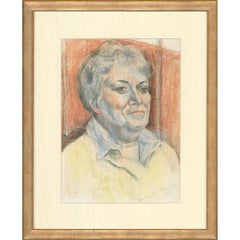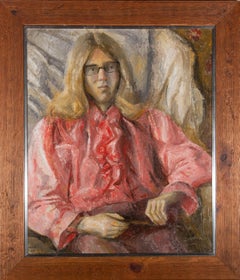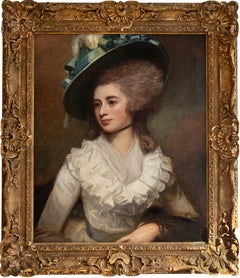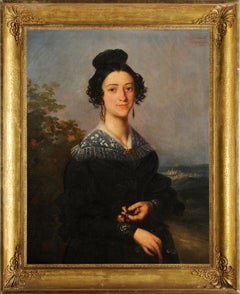Margaret Robinson Art
to
2
2
1
1
Overall Height
to
Overall Width
to
2
2
1
1
1
1
2
2
6,997
3,368
2,513
1,212
1
1
1
1
Artist: Margaret Robinson
Margaret Robinson (1920-2016) - 2013 Pastel, Self Portrait
By Margaret Robinson
Located in Corsham, GB
A fine self portrait by artist Margaret Robinson. Robinson's portraiture skills are demonstrated by her strong sense of line and tone in this striking piece. On wove.
Category
21st Century and Contemporary Margaret Robinson Art
Materials
Pastel
Margaret Robinson (1920-2016) - 20th Century Oil, Study in Pink
By Margaret Robinson
Located in Corsham, GB
An expressive and colourful portrait of a seated woman wearing a pink shirt. Presented in a wooden frame with a silver gilt-effect inner edge. The signature is scratched into the pai...
Category
21st Century and Contemporary Margaret Robinson Art
Materials
Oil
Related Items
Portrait of Lady Caroline Price
By George Romney
Located in Miami, FL
DESCRIPTION: Perhaps the best Romney in private hands. If Vogue Magazine existed in the late 18th century, this image of Lady Caroline Price would be ...
Category
1970s Old Masters Margaret Robinson Art
Materials
Canvas, Oil
Portrait of a young girl
Located in BELEYMAS, FR
Louis Joseph César DUCORNET
(Lille 1806 – Paris 1856)
Portrait of a young girl
Oil on canvas
H. 92 cm; L. 73 cm
Signed upper left, dated 1837
When he came into the world in Lille in...
Category
1830s French School Margaret Robinson Art
Materials
Canvas, Oil
Sketch of a dandy portrait
Located in BELEYMAS, FR
French school circa 1840
Sketch of a dandy portrait
Oil on canvas mounted on cardboard
H. 21 cm; L. 20.5 cm
Category
1830s French School Margaret Robinson Art
Materials
Canvas, Oil
Dibujo a la manera de Velasquez (Drawing in the Manner of Velasquez)
By Fernando Botero
Located in Palm Desert, CA
A drawing by Fernando Botero. "Dibujo a la Manera de Velasquez" is a portrait, charcoal and pastel on cardboard in an earth-tone palette by Latin American artist Fernando Botero. It is signed upper right, "Sobre Velazquez Botero -1-27-60 Para Rita. el recuerdo de uno payaso".
Fernando Botero, best known for his voluptuously rotund human figures, was born in Medellín, Colombia on April 19, 1932. His father died when he was young, and he was raised by his mother, along with his two brothers. He attended a Jesuit school in Medellín and from the age of 12 to 14, he attended a matador training school. The bull fight became a recurring theme in Botero’s early work and while he was in his early teens, he sold his pictures of bull fights in front of the arena.
By the time he was 16 years of age, Botero was working as an illustrator for the local magazine El Colombiano. He also began writing articles about art theory, one of which, entitled Picasso and Non-Conformity in Art, led to his expulsion from the Jesuit school for its endorsement of Cubism. One of Botero’s important early works, Woman Crying...
Category
Mid-20th Century Post-War Margaret Robinson Art
Materials
Charcoal, Pastel, Cardboard
Modern Dancers
By Mick Micheyl
Located in London, GB
'Modern Dancers', pastel, ink and gouache on fine art paper by French artist, singer and sculptor, Mick Micheyl (1964). Two elegant young men are depicted in a graceful dancing pose, arms outstretched, their lithe bodies so agile and limber. Perhaps one of the dancers was her friend, Philippe, to whom the painting is dedicated on the bottom. The dedication says: 'For you Philippe, all my friendship'. Signed: 'Mick Micheyl'. The work has been newly framed and glazed after having been acquired in the S. of France. It is in fair vintage condition commensurate with age showing minor blemishing on the paper. Upon request a video of the piece can be provided.
Dimensions with Frame:
H 75 cm / 29.5"
W 61 cm / 24"
Dimensions without Frame:
H 56 cm / 22"
W 42 cm / 16.5"
About the Artist: Mick Micheyl (1922 - 2019) was born in Lyon and had a busy and rewarding artistic career as a singer, producer, reviewer, metal sculptor, artist. After having received training at the School of Fine Arts in Lyon she became a painter and decorator in the theatre but then commenced a career in the musical activities of a theatrical troupe. She won the ABC competition in Paris in 1949 with a song, Le Marchand de Poésie, which she composed herself. She then performed in many cabarets: L'Échelle de Jacob, Harlequin and Liberty's. In the 1950s she was one of the most important French cabaret singers of that period. One of her titles, 'Un Gamin de Paris', became one of the French standards and also performed by Yves Montand and Robert Clary...
Category
1960s Modern Margaret Robinson Art
Materials
Gouache, Paper, Pastel, Ink
Portrait of Gentleman, Thomas Bruce, Earl of Elgin c.1638 Manor House Provenance
Located in London, GB
Titan Fine Art present this picture which formed part of a historic collection of an English aristocratic family, Lord and Lady Sandys at their magnificent baroque and Regency Grade-I listed family home, Ombersley Court. The house was among the most fascinating survivals of its kind in this country. The atmospheric interiors were distinguished above all for the works of art associated with two key moments in national history and, more specifically, to the roles of Colonel the Hon. John Russell in the Civil War and the reign of King Charles II and of Lord Arthur Hill, later 2nd Baron Sandys, in the Peninsular War. The collection was acquired or commissioned over five centuries and remained at Ombersley Court until its recent sale, the first in 294 years. This painting hung in The Great Hall (see photo).
This charming portrait is an example of the type of small-scale panel portraits, often of splendid beauties of the time, that became fashionable from about the first quarter of the seventeenth century. The sitter has been depicted wearing a low-cut silk dress with the wide billowing sleeves typical of the late 1630’s. The simplicity of the ensemble is reinforced by the absence of lace on either the collar or cuffs. At this time gone are the complicated layers of fabrics, and now replaced with understated elegance of plain silk (satin and taffeta were most popular), with only a couple of focal points as accessories. There is an abundance of the accessory par excellence – pearls, and they are worn as a necklace, on her attire, and as earrings; the pear-shaped earrings are called ‘unions excellence’ reflecting the difficulty of finding perfectly matched pearls of such large size. They could range up to 20 millimetres in diameter. There is a splendid display of gold, diamond and pearl jewellery which is an obvious sign of her wealth.
The portrait is thought to represent Thomas Bruce (1596-1654), Earl of Elgin. The physiognomy and features in our portrait strongly correlate to a portrait of the Earl, by Cornelius Johnson (1593-1661), painted circa 1638, and is held at Kenwood House, London. Another painting from Ombersley Court, also with Titan Fine Art, is contemporaneous to ours and is thought to represent the Earl’s wife, Diana Cecil, 1st Countess of Elgin (c.1603-1654) - it appears to have derived from Cornelius Johnson’s depiction of the Countess circa 1638, also at Kenwood House. During the 1630’s Johnson painted a number of portraits, obviously influenced by Van Dyke. Here, Theodore Russel, who worked in the studios of both Van Dyle and Johnson, and later specialised in small scale reproductions of his master’s works, modelled the head, with the striking large dark eyes, on Cornelius Johnson, and the attire on Anthony van Dyke. There are also other portraits by Johnson of the sitter with very similar facial features to that of the sitter in ours. Theodore Russel and Cornelius Johnson also had a family connection as it is thought that Russel’s step-mother was a sister of Johnson.
Thomas Bruce, 1st Earl of Elgin, was a prominent Scottish nobleman who held titles such as the 3rd Lord Bruce of Kinloss. He resided at Houghton House in Bedfordshire and played a significant role in the political and social landscape of his time. His legacy as an Earl and Lord continues to be remembered in history.
Thomas Bruce, born in Edinburgh in 1599, inherited the Scottish peerage title as the 3rd Lord Bruce of Kinloss at the age of 13 following his brother's untimely death in a duel. The family's estates, including Whorlton Castle and manor, were granted by King James I of England to Thomas's father, with the wardship of Thomas and the estates entrusted to his mother until he reached the age of 21. He maintained a strong connection with King Charles I's court during the Personal Rule, receiving titles of honour and prestigious roles throughout the years.
Thomas Bruce was married twice in his lifetime. His first marriage was to Anne Chichester in 1622. Ann died in 1627, the day after giving birth to their only child, Robert Bruce, who later became the 1st Earl of Ailesbury. On 12 November 1629, Thomas Bruce married Lady Diana Cecil, the daughter of William Cecil and widow of Henry de Vere. The marriage was childless, but Diana brought significant estates with her. Thomas Bruce died on 21 December 1663 at the age of 64.
This oil on panel portrait has been well cared for over its life, which spans almost four centuries. Having recently undergone a treatment to remove an obscuring discoloured varnish, it can be fully appreciated, and attributed to Theodore Russel.
Once owned by Evesham Abbey, the manor of Ombersley was acquired by the Sandys family in the early 1600s, when Sir Samuel Sandys, the eldest son of Edwin Sandys, Bishop of Worcester and later Archbishop of York, took a lease on the manor, before receiving an outright grant in 1614. The present house, Ombersley Court, dates from the time of Samuel, 1st Lord Sandys, between 1723 and 1730. The house itself is a fine example of an English Georgian country house set in rolling countryside and surrounded by Wellingtonias, planted to commemorate the Battle of Waterloo by Arthur Hill, 2nd Baron Sandys, who played a distinguished part in the battle and was one of the Duke of Wellington’s aides de camp. The Duke also stayed in the house and in the Great Hall, was the Waterloo banner which was brought to the house by Sir Arthur Hill, aide-de-camp to the Duke of Wellington, who succeeded his mother, the Marchioness of Downshire as 2nd Lord Sandys. Further Waterloo memorabilia are kettle drums from battle. The family had a strong tradition of military and political service, dating back to the 17th century, and this was also reflected in the fine collection of portraits and paintings in the house. In short, Ombersley represented a vital aspect of British history. The house and more especially the collection were of the greatest historical importance. Houses that have remained in the possession of the same family for as many as three centuries have become increasingly rare.
Through this portrait, collectors have a chance to acquire a piece of British history and an evocative vestige of a glittering way of life, which is now gone.
Presented in a fine period frame.
Theodore Russell, or Roussel, was born in London in 1614. His father came from Bruges to England and was the Royal Stuart jeweller. His apprenticeship was spent in the studio of his uncle, Cornelius Johnson, with whom he lived for about nine years. Sometime after 1632, he is said to have worked as an assistance to Van Dyck. He executed numerous copies of portraits by his famous master and other notable painters, also painting original works. He is particularly remembered for his portraits of Charles II at Woburn Abbey and James II at the Palace of Holyrood. His son, Antony Russel (c.1663–1743) was also a portrait-painter and is said to have studied under John Riley. Several of his copies were in the Royal Collections, and among the nobility.
Provenance
Richard Hill...
Category
17th Century Old Masters Margaret Robinson Art
Materials
Oil, Wood Panel
H 18.9 in W 16.15 in D 1.58 in
Oil Painting / Photorealism / Figurative Art / Human Figure /Museum
By Bruce Adams
Located in Buffalo, NY
Bruce Adams was a painter, art educator, and writer. Born in Buffalo, N.Y., in 1952, he received a B.S. in 1976 and an M.A. in 1983 from Buffalo State College. Adams’s work is includ...
Category
1980s Contemporary Margaret Robinson Art
Materials
Canvas, Oil
Portrait of a Lady Diana Cecil, Countess of Elgin c.1638, Manor House Provenance
Located in London, GB
Titan Fine Art present this picture which formed part of a historic collection of an English aristocratic family, Lord and Lady Sandys at their magnificent baroque and Regency Grade-I listed family home, Ombersley Court. The house was among the most fascinating survivals of its kind in this country. The atmospheric interiors were distinguished above all for the works of art associated with two key moments in national history and, more specifically, to the roles of Colonel the Hon. John Russell in the Civil War and the reign of King Charles II and of Lord Arthur Hill, later 2nd Baron Sandys, in the Peninsular War. The collection was acquired or commissioned over five centuries and remained at Ombersley Court until its recent sale, the first in 294 years. This painting hung in The Great Hall (see photo).
This charming portrait is an example of the type of small-scale panel portraits, often of splendid beauties of the time, that became fashionable from about the first quarter of the seventeenth century. The sitter has been depicted wearing a low-cut silk dress with the wide billowing sleeves typical of the late 1630’s. The simplicity of the ensemble is reinforced by the absence of lace on either the collar or cuffs. At this fashion moved away from complicated layers of fabrics to an understated elegance of plain silk (satin and taffeta were most popular) with only a couple of focal points as accessories. However, obligatory for any respectable woman, pears are shown in abundance, as a necklace, on the dress attire, and pear-shaped earrings called ‘unions excellence’ reflecting the difficulty of finding perfectly matched pearls of such large size. They could range up to 20 millimetres in diameter. There is a splendid display of gold, diamond and pearl jewellery which is an obvious sign of her wealth.
The subject is thought to be Diana Bruce née Cecil, 1st Countess of Elgin (c.1603-1654). The physiognomy and features strongly correlate to a portrait of the countess by Cornelius Johnson (1593-1661), painted circa 1638, at Kenwood House, London. Another painting from Ombersley Court, also with Titan Fine Art, is contemporaneous to this and is thought to represent the countess’s husband, Thomas Bruce, 1st Earl of Elgin (1599-1663) – it appears to have derived from Cornelius Johnson’s portrait of the Earl, of circa 1638, also at Kenwood House. During the 1630’s Johnson painted a number of portraits, obviously influenced by Van Dyke. Here, Theodore Russel, who worked in the studios of both Van Dyle and Johnson, and later specialised in small scale reproductions of his master’s works, appears to have modelled the head, with the striking large dark eyes, on Cornelius Johnson, and the attire on Anthony van Dyke. Theodore Russel and Cornelius Johnson also had a family connection as it is thought that Russel’s step-mother was a sister of Johnson.
Diana Cecil, Countess of Oxford (1596–1654), later Countess of Elgin, was an English aristocrat. She was probably the middle daughter of the three daughters of William Cecil, 2nd Earl of Exeter and Elizabeth Drury. Her first husband, Henry de Vere, 18th Earl of Oxford, died in battle only 18 months after their marriage in 1624. She married her second husband Thomas Bruce (1599-I663) in 1629, becoming the Countess of Elgin in 1633. Her portrait was presumably painted at a similar time as the companion portrait of her husband, the Earl of Elgin. She died in 1654, outlived by her husband and leaving no children. A large monument exists of the countess in her burial shroud at Ailesbury Mausoleum, Bedfordshire.
The work has been well cared for over its life, which spanning almost four centuries, and having recently undergone a treatment to remove an obscuring discoloured varnish, it can be fully appreciated, and attributed to Theodore Russel.
Once owned by Evesham Abbey, the manor of Ombersley was acquired by the Sandys family in the early 1600s, when Sir Samuel Sandys, the eldest son of Edwin Sandys, Bishop of Worcester and later Archbishop of York, took a lease on the manor, before receiving an outright grant in 1614. The present house, Ombersley Court, dates from the time of Samuel, 1st Lord Sandys, between 1723 and 1730. The house itself is a fine example of an English Georgian country house set in rolling countryside and surrounded by Wellingtonias, planted to commemorate the Battle of Waterloo by Arthur Hill, 2nd Baron Sandys, who played a distinguished part in the battle and was one of the Duke of Wellington’s aides de camp. The Duke also stayed in the house and in the Great Hall, was the Waterloo banner which was brought to the house by Sir Arthur Hill, aide-de-camp to the Duke of Wellington, who succeeded his mother, the Marchioness of Downshire as 2nd Lord Sandys. Further Waterloo memorabilia are kettle drums from battle. The family had a strong tradition of military and political service, dating back to the 17th century, and this was also reflected in the fine collection of portraits and paintings in the house. In short, Ombersley represented a vital aspect of British history. The house and more especially the collection were of the greatest historical importance. Houses that have remained in the possession of the same family for as many as three centuries have become increasingly rare.
Through this portrait, collectors have a chance to acquire a piece of British history and an evocative vestige of a glittering way of life, which is now gone.
Presented in a fine period frame.
Theodore Russell, or Roussel, was born in London in 1614. His father came from Bruges to England and was the Royal Stuart jeweller. His apprenticeship was spent in the studio of his uncle, Cornelius Johnson, with whom he lived for about nine years. Sometime after 1632, he is said to have worked as an assistance to Van Dyck. He executed numerous copies of portraits by his famous master and other notable painters, also painting original works. He is particularly remembered for his portraits of Charles II at Woburn Abbey and James II at the Palace of Holyrood. His son, Antony Russel (c.1663–1743) was also a portrait-painter and is said to have studied under John Riley. Several of his copies were in the Royal Collections, and among the nobility.
Provenance
Richard Hill...
Category
17th Century Old Masters Margaret Robinson Art
Materials
Oil, Wood Panel
H 18.9 in W 16.15 in D 1.58 in
Self-Portrait In Pastels - 21st Century Russian Contemporary Drawing
By Ksenya Istomina
Located in Nuenen, Noord Brabant
This pastel drawing without it's frame and passe-partout is 29 x 20 cm, of course it will be shipped, with the 'Clarity museum glass', passe- partout and frame.
Ksenya Istomina made...
Category
2010s Contemporary Margaret Robinson Art
Materials
Pastel
Free Shipping
H 18.51 in W 14.57 in
Men portrait
By Giovanni Maria delle Piane dit Mulinaretto (Genoa 1670 - Monticelli d´Ongina 1745)
Located in BELEYMAS, FR
Giovanni Maria DELLE PIANE, known as IL MULINARETTO
(Genoa, 1660 – Monticelli d'Ongina, 1745)
Portrait of a man
Oil on oval canvas
H. 108 cm; L. 83 cm
Proven...
Category
1730s Italian School Margaret Robinson Art
Materials
Canvas, Oil
Free Shipping
H 42.52 in W 32.68 in
ENOCH SEEMAN (circle of) PORTRAIT OF SIR FRANCIS SEYMOUR AS A BOY
By Enoch Seeman
Located in York, GB
ENOCH SEEMAN (circle of) PORTRAIT OF SIR FRANCIS SEYMOUR AS A BOY
A very fine 18th century portrait of Sir Francis Seymour as a boy,oil on canvas housed in a gilt frame, circle of Enoch Seeman
The size of the painting is 49 x 39.5cm (19¼ x 15½ in.) whilst overall the size is 65 cm x 56 cm
The painting is in very good condition, the Canvas has been relined, and recently cleaned.
Provenance: Anonymous sale, Christie's, 19 January 1945, lot 34 Anonymous sale, Crewkerne, Somerset, 24 April 2009, lot 1947
SIR FRANCIS SEYMOUR
Francis Seymour, 1st Baron Seymour of Trowbridge (c. 1590 – 12 July 1664), of Marlborough Castle and Savernake Park in Wiltshire, was an English politician who sat in the House of Commons at various times between 1621 and 1641 when he was raised to the peerage as Baron Seymour of Trowbridge. He supported the Royalist cause during the English Civil War.
In June 1611 he was accused of abetting the escape of his brother William Seymour and his wife Arabella Stuart, but protested his innocence. He was knighted by King James I at Royston on 23 October 1613. In 1612 was settled on him by his grandfather the manor of "Puriton with Downend" in Somerset, formerly one of the many possessions of his great-grandfather the 1st Duke of Somerset.
In June 1642, Seymour signed the declaration that the king had no intention of war. He followed the King to York, offering to raise twenty horse in his cause, and Parliament accordingly declared him a delinquent. In autumn 1642 he went with his brother, the Marquis of Hertford, into the Westcountry to organise the royalist forces and suppress the parliamentary militia. He crossed the Bristol Channel...
Category
18th Century Realist Margaret Robinson Art
Materials
Oil
Pair of 19th century English chalk drawing on paper of Cockerel
By William Huggins
Located in Woodbury, CT
William Huggins was born in Liverpool, England on the 13th of May, 1820. His parents were Samuel and Elisabeth Huggins. He took his first drawing lessons from the Liverpool Mechanics...
Category
1870s Victorian Margaret Robinson Art
Materials
Paper, Pastel
Free Shipping
H 9 in W 10 in
Previously Available Items
Margaret Robinson (1920-2016) - 1992 Oil, Feeling Blue
By Margaret Robinson
Located in Corsham, GB
A wonderfully engaging portrait in a charming naive style, showing a young woman in blue tones. Indistinct hands can be seen in the background. The artist has signed and dated to the...
Category
20th Century Margaret Robinson Art
Materials
Oil
Margaret Robinson art for sale on 1stDibs.
Find a wide variety of authentic Margaret Robinson art available for sale on 1stDibs. You can also browse by medium to find art by Margaret Robinson in crayon, oil paint, paint and more. Not every interior allows for large Margaret Robinson art, so small editions measuring 17 inches across are available. Margaret Robinson art prices can differ depending upon medium, time period and other attributes. On 1stDibs, the price for these items starts at $428 and tops out at $513, while the average work can sell for $471.




